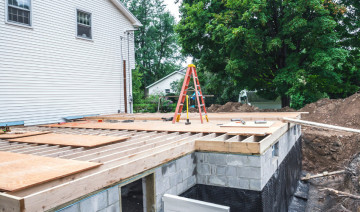{article.name}
Guide to Planning a Home Addition

- Share this:
- Share on Facebook
- Pin on Pinterest
- Tweet on Twitter
A home addition can be a great way to adapt and update your home, increase its property value, and create exciting new spaces you and your family can enjoy for years or even generations to come. The project, however, can also be intimidating and overwhelming, especially if you have never tackled such an intense undertaking before. This guide to planning a home addition can help you maneuver through the process to create a larger, more versatile, amazing home you will love.
Do You Need a Home Addition?
Before jumping into a home addition project, consider very carefully whether you need an addition at all. These projects are massive investments of time, labor, and money, and can be dramatic disruptions to your daily life for weeks or months. It is important to be certain you need such an addition long before you begin.
First, consider how your family’s needs are changing. Is it possible to adapt your existing space to meet these changes? For example, converting a guest room into a home office may be easier and less expensive. Similarly, consider whether existing space can be refit for multi-purpose uses, such as adding a hobby nook to a larger family room rather than planning a whole new craft room. At the same time, look ahead to how new space may be used in the years to come to be sure it will continue to be useful and valuable. Finally, consider whether you may be selling your home in the next few years, and how an addition could impact its value with respect to gaining back the investment or improving sales possibilities.
Most Common Home Additions
There are many home additions that can be made to any size, style, or structure of home. Depending on your home’s features and what you want for an addition, popular options include:
- Adding a new floor to dramatically increase square footage
- Converting an existing porch, garage, basement, or attic into livable space
- Enclosing a carport for an additional room or rooms
- Creating an in-law suite for a multi-generational home
- Adding an enclosed sunroom or creating outdoor living space
- Extensions to a kitchen or bath, or to create additional rooms
Understanding the purpose of your home addition is critical to ensure you are happy with the results you build. Regardless of the type of addition, the planning process is similar to ensure the project goes as smoothly as possible.
Steps to Planning a Home Addition
When you are ready to plan a home addition project, following these key steps can help the process stay on target for your home improvement goals.
- Define Your Budget
Knowing how much you can spend is critical to get estimates, make down payments, and purchase materials. Always expect charges to be 10-15% higher than initially estimated for unexpected changes or difficulties, and ask about financing options through your bank or contractors as necessary. Saving in advance is a good way to feel comfortable with the expense of a home addition, or you can consider refinancing your home or securing a home equity line of credit for additional budgeting.
- Investigate Permits
Many municipalities require specific permits related to home additions, and there may be restrictions or limitations on home construction projects such as maximum structure height, how close you can build to property lines, necessary materials, or other guidelines, and violations may result in exorbitant fines. Note whether you will have to secure the proper permits, or if contractors include the appropriate paperwork in their services.
- Hire Professionals
If you have do-it-yourself expertise, it can be tempting to tackle a home addition on your own. Even what first appears to be a simple project can quickly become much more involved, however, and it is always best to hire professionals to ensure the job is managed safely and efficiently. Consult with different contractors to find those whom you are confident working with, including architects, electricians, plumbers, roofers, landscapers, or whatever other experts your addition will require.
- Study Contracts
Before the project begins, study the contracts you have with contractors thoroughly so you understand the terms and conditions of their services. This includes how flexible estimates may be, the timeline for the work, how emergencies may be handled, whether you can make changes as the project proceeds, how payments are to be made, who is to have access to your home, and other details that outline how you and your contractors will work together.
- Survey the Site
Properly surveying your home and the immediate area for the expansion is critical for a successful project that will suffer fewer setbacks. Outside, note where property lines are, as well as underground gas and water lines, sprinklers, or buried electrical lines. Also consider the terrain so heavy equipment can safely operate. Inside, note if there are load-bearing walls that cannot be removed, and how electrical wiring, plumbing, or ductwork may need to be adjusted. Good surveys will help ensure more accurate cost and timeline estimates and fewer surprises as the project progresses.
- Communicate Thoroughly
Speak up with your contractors to ensure they are aware of your expectations and preferences, no matter how small. If you prefer workers to be finished at a certain time of day (when kids get home from school, for example), or if you need to take a break for holidays, travel, or special occasions, see if that can be worked into the schedule. As the project advances, talk to your contractors right away if something isn’t looking the way you’d like – a paint color, for example – so adjustments can be made right away and change costs will be minimal.
- Be Open to Options
While you may have firm ideas of what you do or don’t want in a home addition, be flexible and listen to your contractors’ recommendations. They may know of alternatives you would not have considered and can help you make the best choices to meet your needs, especially if you have thoroughly communicated your hopes and preferences before the work begins. Furthermore, an open mind can help you adjust more easily to any necessary changes, such as if there are unexpected difficulties as the project moves along.
- Plan for Disruption
Any home addition is an intensive, intrusive project into your home life. Be prepared with alternative living arrangements if necessary, such as staying with nearby friends or relatives if it won’t be possible to remain in your home for part of the project. Consider a short term rental as an option, or plan workarounds that will accommodate your family, such as everyone using a different bathroom, rearranging bedrooms, or planning fewer cooked meals as needed while the project is underway and parts of your home may be inoperative or inaccessible.
Thorough planning is absolutely necessary for any home addition, no matter how large or small the project may be. If you have properly planned, there will be fewer unpleasant surprises as the work progresses, and the entire process will be smoother and more efficient. This can save money, time, and stress, and help you be more prepared to enjoy your new addition in all the best ways possible.
Sign up for our Email List
Stay updated with all our latest posts, products and offers! Just enter your information below.

Comments